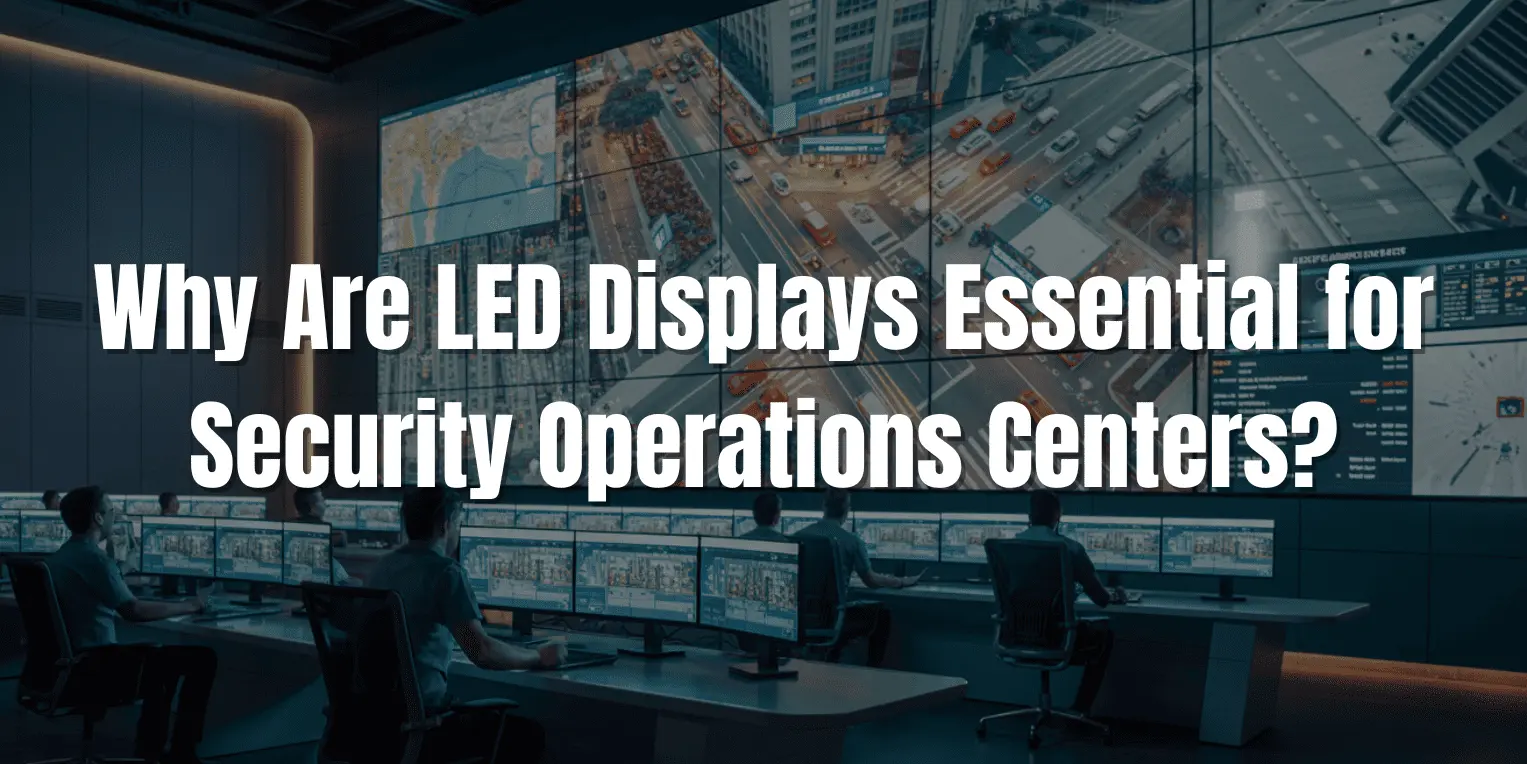Your security team is your first line of defense. However, the entire operation is compromised if they miss one critical detail on a blurry screen. This is a risk you cannot afford.
LED displays are essential for Security Operations Centers (SOCs) because their seamless, high-contrast visuals and 24/7 reliability ensure operators never miss critical information. They eliminate bezel distractions and the risk of image burn-in common with static displays, guaranteeing constant readiness.

I have reviewed dozens of control room setups in my two decades in this industry. A typical pattern I've observed is that organizations invest heavily in top-tier cameras but then display the feeds on outdated or inappropriate monitor walls. This creates a critical weakness at the final stage of surveillance1. Specifically, the bezels on traditional LCD video walls create blind spots. This simple observation reinforced my belief that the display technology must be part of the security strategy for mission-critical environments2. It's not just about seeing an image; it's about seeing the whole image, without interruption.
Why Are LED Displays Essential for Security Operations Centers?
How Do Fine-Pitch LEDs Compare to Traditional LCD Video Walls?
Choosing a video wall isn't just about screen size. You're worried that distracting lines between screens could hide a threat, or that a screen will fail at the worst possible moment.
Fine-pitch LED screens create a single, perfectly seamless canvas, eliminating the visual gaps in LCD walls. They also offer superior brightness, contrast, and color uniformity, and are immune to the image burn-in that plagues LCDs in 24/7 security environments.

For an experienced system engineer, the technical specifications are everything. The choice between LED and LCD isn't a matter of preference; it's a decision based on performance and reliability under pressure. When I started iSEMC, I aimed to engineer products that excelled in the most demanding situations. This is perfectly illustrated by comparing these two technologies for a mission-critical SOC. While LCDs have their place in less critical applications, their inherent limitations make them a compromise in a high-security setting where every detail matters.
The Bezel Problem
The most obvious difference is the bezel. LCD video walls are made of individual monitors tiled together. Even with today's "ultra-narrow" bezels, there is always a grid of black lines crisscrossing the larger image. In a security context, this is a significant flaw. A suspect, a vehicle, or a critical alert icon can be partially or fully hidden in these dead zones. On the other hand, fine-pitch LED technology consists of smaller modules that fit together with no gaps. This creates a continuous and uninterrupted visual surface, paramount for surveillance1.
Image Quality and Longevity
SOCs often display static elements on end—maps, building layouts, or system status dashboards for hours. On an LCD screen, this leads to permanent image retention, or "burn-in," where a faint ghost of the image remains on the screen. LEDs are not susceptible to this phenomenon at all. Furthermore, LEDs offer far superior contrast, allowing operators to discern details in dark, shadowy areas of a camera feed, a common challenge in video surveillance1. Their operational lifespan, often exceeding 100,000 hours, means they maintain their brightness and color consistency for years of continuous, 24/7 operation.
What Makes LED Technology Uniquely Suited for 24/7 Monitoring?
A control room can never go dark. The fear that a power supply will fail or a screen will die during a live incident keeps system managers up at night, because uptime is non-negotiable.
LED systems are engineered for continuous operation with built-in redundancy. They feature dual power supplies and signal paths, so the backup takes over instantly if one component fails. This ensures the video wall remains active and reliable, even during maintenance or component failure.

Building a truly reliable product was the mission that drove me to create iSEMC. This commitment came from a deep understanding that failure is not an option for our customers. For a Security Operations Center, uptime is not a feature; it's the most fundamental requirement. LED display systems are designed from the ground up with this principle of resilience. You're not just buying a screen but investing in a fail-safe visual system architected for continuous operation. This principle of redundancy3 is at the core of our design philosophy.
Designed for Redundancy
The foundation of LED reliability is redundancy3. Any single point of failure within a system represents a vulnerability. That's why professional-grade LED cabinets are designed with dual systems for their most critical components.
- Redundant Power Supplies: Each cabinet has at least two parallel power supplies. If one fails for any reason, the other instantly takes the full load without flicking or interrupting the display. The system can simultaneously alert the operator that a PSU needs to be replaced.
- Redundant Signal Paths: Similarly, the video signal that tells the LEDs what to display is duplicated. The cabinets have two receiver cards, sending the signal through two independent paths. If one cable is disconnected or a component fails, the secondary path is active, ainsuring the image remains on screen without interruption.
Hot-Swappable Maintenance
This redundancy3 also allows for "hot-swappable" maintenance. If an LED module, power supply, or receiver card needs to be replaced, a technician can do it while the rest of the display is still running. There is no need to shut down the entire video wall to service one small part. For a 24/7 SOC, this ability to perform maintenance with zero downtime is critical. It ensures the security team maintains full situational awareness at all times, without compromise.
Can LED Displays Provide the Visual Clarity Needed for Detailed Surveillance?
Operators are watching multiple feeds for hours. If the image is fuzzy or lacks detail, they can't effectively identify a face, read a license plate, or spot a hidden threat in a complex scene.
Yes, modern fine-pitch LED displays provide exceptional clarity. Their high pixel density creates sharp, detailed images from close viewing distances. Superior contrast ratios and HDR capability also mean operators can see critical details in a video feed's darkest shadows and brightest highlights.

Clarity is everything in surveillance1. A surveillance1 image is worthless if its critical information is a blurry mess. As an engineer, I find the recent advancements in fine-pitch LED technology particularly exciting because they have fundamentally changed what is possible in control room design. In the past, video walls had to be viewed from a distance to look sharp. Today, we can build video walls as crisp as a desktop monitor, even when an operator stands just a few feet away. This has profound implications for how an SOC can be designed and operated.
The Importance of Pixel Pitch
The key to this clarity is "pixel pitch4," which is the distance between the center of one LED and the center of the next, measured in millimeters. The smaller the pixel pitch4, the higher the pixel density and the sharper the image appears. A few years ago, a 3.0mm pixel pitch4 was considered "fine." We routinely install walls with a 1.5mm, 1.2mm, or even sub-1mm pitch. For a Security Operations Center, you can display a 4K camera feed in its native resolution on a relatively small section of the wall, allowing operators to see every pixel of detail captured without any down-scaling.
High Dynamic Range (HDR) for Superior Vision
Security footage is notoriously challenging from a visual standpoint. A camera might be pointed at a dark alleyway adjacent to a brightly lit street. On a standard display, you must choose between seeing the detail in the shadows (and blowing out the highlights) or seeing the detail in the bright areas (and crushing the blacks into an indistinct blob). High Dynamic Range (HDR)5 technology in modern LED displays6 solves this problem. It allows the display to show a much wider range of brightness and color within the same scene. This means operators can clearly see the person hiding in the dark alley and the car's license plate on the sunny street, all in the same image.
Is an LED Video Wall a Cost-Effective Investment in the Long Run?
The high initial price of an LED wall can be a significant hurdle. You're pressured to choose a cheaper LCD solution, but worry about hidden costs like maintenance, replacements, and high energy bills.
While the upfront cost is higher, an LED video wall often has a lower Total Cost of Ownership (TCO). Its significantly longer lifespan, superior energy efficiency, and lower maintenance requirements result in substantial long-term savings compared to an LCD wall that requires more frequent replacement.

I often speak with clients focused on the initial purchase budget and completely understand that pressure. However, part of my role is to help them see the whole picture over the intended life of the system. We always encourage a Total Cost of Ownership (TCO)7 analysis. A system engineer isn't just responsible for the initial installation; they are often responsible for the system's performance and maintenance budget for the next five to ten years. When you analyze the full lifecycle cost, the math usually points to LED as the more prudent long-term investment.
Breaking Down the Total Cost of Ownership (TCO)
TCO looks beyond the purchase price to include all costs associated with a product over its operational lifetime. For video walls, the key factors are:
- Lifespan & Replacement: A high-quality LED wall is rated for over 100,000 hours of use. An LCD wall's backlight is typically rated for 50,000-60,000 hours, after which brightness and color uniformity8 decline sharply. This means you have to purchase and install an entire LCD wall twice in the lifespan of a single LED wall.
- Energy Consumption: Modern LEDs are very energy efficient. They don't require a constant, powerful backlight like LCDs do. When displaying images with large black or dark areas—common in surveillance1—the LEDs in those areas are turned off, consuming almost no power. This can lead to significant energy savings over the years of 24/7 operation.
- Maintenance Costs: If a single LCD panel in a video wall fails, you have to replace the entire, expensive panel. With a modular LED wall, a technician only needs to replace one or two small, relatively inexpensive modules if a small section is damaged or fails. This makes repairs faster, easier, and far more cost-effective.
When you factor in these long-term elements, the higher initial investment in an LED wall is often paid back through lower operational and replacement costs over its lifespan.
Conclusion
LED displays6 are the essential foundation for any security center where failure is not an option. They deliver the uncompromising reliability, seamless clarity, and long-term value that all mission-critical operations demand.
Footnotes
- Explore the role of advanced surveillance technology in enhancing security. ↩
- Understand the unique requirements of environments where failure is not an option. ↩
- Understand how redundancy ensures continuous operation in critical environments. ↩
- Learn how pixel pitch influences the sharpness of displayed images. ↩
- Discover how HDR technology enhances visibility in complex scenes. ↩
- Explore how LED displays enhance visibility and reliability in security operations. ↩
- Understand how TCO analysis can guide investment decisions in display technology. ↩
- Learn how consistent color improves detail recognition in surveillance feeds. ↩





